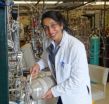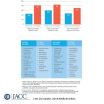(Press-News.org) Scientists have uncovered key attributes of so-called "brown carbon" from wildfires, airborne atmospheric particles that may have influenced current climate models that failed to take the material's warming effects into account. The work was described by a collaborative team of researchers from Los Alamos National Laboratory, Carnegie Mellon University and the University of Montana in the journal Nature Geosciences this week.
"Biomass burning and wildfires emit fine particulates that are toxic to humans and can warm or cool climate. While their toxicity is certain, their specific climatic effects remain unclear and are a hot research topic," said Manvendra Dubey, a senior Los Alamos climate scientist. "Smoke from wildfires accounts for one-third of the Earth's 'black' carbon — the familiar charred particles that are associated with fires with large flames. While black carbon is relatively simple — solely consisting of carbon — brown carbon contains a complex soup of organic material, making it difficult to identify, characterize and model."
Black carbon or soot that absorbs sunlight at all wavelengths is a well-known, potent warmer. Its twin, organic carbon co-emitted by fires, reflects sunlight and so can cool the climate. These two opposing effects cancel each other out, causing current climate models to predict that wildfires have a small net effect on climate. However, there is a third form of emission, called brown carbon, that absorbs sunlight at short blue wavelengths that is also in the soup of fire emissions.
The study discovered that brown carbon shares a common production mechanism with black carbon. Brown carbon's optical properties and volatility are highly variable and complex and no systematic treatment has been feasible in current models. In fact "what makes matters worse is many models treat brown carbon as organic carbon, a double whammy since they are computing a cooling effect for what is actually a warming particle," said Dubey. Clearly, he said, models could be significantly under-estimating warming effect of fires both now and in the future.
"You might call brown carbon frustrated black carbon that is made when the wood isn't fully cooked all the way," said Dubey. Brown carbon warms the atmosphere similarly to black carbon, but the actual prevalence of brown carbon in wildfire smoke has been a large question mark. This study should answer this by providing a simple treatment of all absorbing fire particles in models and improve climate predictions.
The Los Alamos team of Dubey, Allison Aiken and Shang Liu performed controlled laboratory experiments of the optical properties of particles emitted by globally important fuels. They carefully manipulated the particles by heating to remove the volatile components and then monitored changes in optical properties. Analysis revealed that the least volatile fraction, that is most likely to be transported globally similar to refractory black carbon, is much more light absorbing than the volatile fraction.
This finding clearly establishes the "global significance of brown carbon aerosol, a research area prioritized by DOE's Atmospheric System Research (ASR) program, and our discovery shows how this missing warming agent can be effectively treated in DOE's climate models" said Dubey.
The three-institution research team included both experimentalists and modelers who understand each other's languages and the experimentalists, know what the modelers need, and had this in mind for the experimental design, noted Rawad Saleh, a postdoctoral researcher at Carnegie Mellon and one of the leads on the study.
INFORMATION:
The U.S. Department of Energy's Atmospheric System Research Program funded the Los Alamos research.
http://www.nature.com/ngeo/journal/vaop/ncurrent/full/ngeo2220.html
About Los Alamos National Laboratory
Los Alamos National Laboratory, a multidisciplinary research institution engaged in strategic science on behalf of national security, is operated by Los Alamos National Security, LLC, a team composed of Bechtel National, the University of California, The Babcock & Wilcox Company, and URS for the Department of Energy's National Nuclear Security Administration.
Los Alamos enhances national security by ensuring the safety and reliability of the U.S. nuclear stockpile, developing technologies to reduce threats from weapons of mass destruction, and solving problems related to energy, environment, infrastructure, health, and global security concerns. END
Scientists uncover combustion mechanism to better predict warming by wildfires
Brown carbon's heating effect in climate models can now be quantified
2014-08-04
ELSE PRESS RELEASES FROM THIS DATE:
Fires not slowing around Yellowknife
2014-08-04
Fires and the resultant smoke that comes from them are both just as widespread and heavy as they were in the month of July. Hundreds of fires dot the landscape and the Northwest Territories Live Fire map shows the extent of the wildfires and hot spots that have been reported. Fire danger around this area of the Northwest Territories remains in either the high or extreme range. On the live fire map, notated detections of new fires number in the dozens. These fires are ones having been detected within the last 24 hours. Residents of Yellowknife were witness to red lightning ...
'I cant figure out how to do this!'
2014-08-04
"Physics summer work, please help!!!," a post on Yahoo! Answers begins. "I cant figure out how to do this anywhere!!! Best answer awarded? Need help immediately!!!!!."
Most of the science and math queries on Yahoo! Answers resemble this one, although some are less hysterical. But they all make people who love science and teaching science cringe. It's not that they think the students are "cheating" by trying to google the answer, but rather that they know students who ask this kind of question are learning nothing and probably confirming a secret conviction that they're ...
Speedier diagnosis of diseases such as cancer likely thanks to new DNA analysis technique
2014-08-04
Researchers from McGill University and the Génome Québec Innovation Centre have achieved a technical breakthrough that should result in speedier diagnosis of cancer and various pre-natal conditions.
The key discovery, which is described online this week in the Proceedings of the National Academy of Sciences (PNAS), lies in a new tool developed by Professors Sabrina Leslie and Walter Reisner of McGill's Physics Department and their collaborator Dr. Rob Sladek of the Génome Québec Innovation Centre. It allows researchers to load long strands of DNA into a tunable nanoscale ...
In defense of mouse models for studying human disorders
2014-08-04
Mouse models of human diseases are essential research tools that are widely used in the medical sciences to increase our understanding of the pathogenesis and pathophysiology of various diseases, and to search for cures. Despite the widespread use of mice as animal models of disease, in 2013, Seok et al. reported that mouse models poorly mimic human inflammatory diseases, such as severe burn injury, sepsis, and acute infection, in terms of gene expression (PNAS 2013, 110(9), 3507-3523), which has been cited more than 400 times since its publication only 18 months ago. Their ...
Sulfur signals in Antarctic snow reveal clues to climate, past and future
2014-08-04
Sulfur signals in the Antarctic snow have revealed the importance of overlooked atmospheric chemistry for understanding climate, past and future.
Eruptions of huge volcanoes, the disruptive weather pattern known as El Niño, and a fire season from hell each left distinctive chemical marks in layers of snow excavated near the South Pole, researchers from the University of California, San Diego and France report in the Proceedings of the National Academy of Sciences the week of August 4.
Sorting out the chemical reactions that must have led to those traces revealed a process, ...
Overtreatment and undertreatment of patients with high blood pressure linked to kidney failure and death
2014-08-04
PASADENA, Calif., August 4, 2014 — The mantra for treatment for high blood pressure has been "the lower, the better," but that goal can potentially put patients at risk of kidney failure or death, according to a Kaiser Permanente study published today in the Journal of the American College of Cardiology.
Researchers examined the electronic health records of nearly 400,000 Kaiser Permanente patients in Southern California who were taking medications to treat high blood pressure from January 2006 through December 2010. They found that:
patients within the range between ...
A polypill strategy to improve global secondary cardiovascular prevention
2014-08-04
WASHINGTON (Aug. 4, 2014) — The polypill, a combination pill taken just once a day that includes key medications for secondary prevention of heart disease, may be an effective low-cost strategy to improve adherence to medication recommendations and reduce costs, according to researchers from Spain and New York, who reviewed research on the polypill.
The review article, A Polypill Strategy to Improve Global Secondary Cardiovascular Prevention, was published online today in the Journal of the American College of Cardiology and will appear in the August 12, 2014 print issue. ...
Protective hinge process enables insulin to bind to cells
2014-08-04
CLEVELAND – August 4, 2014 – Since its landmark discovery in 1922, insulin has improved the health and extended the lives of more than 500 million people worldwide with diabetes mellitus. Yet the question of how this key hormone binds to its target cells in the body’s organs has posed an enduring scientific mystery. A global team of researchers from Cleveland, Australia, Chicago, India and Oregon has made a discovery about insulin and its structure that promises to enable design of new insulin products that will do a better job of regulating the metabolism of patients with ...
Blood-oxytocin levels in normal range in children with autism, study finds
2014-08-04
Autism does not appear to be solely caused by a deficiency of oxytocin, but the hormone's universal ability to boost social function may prove useful in treating a subset of children with the developmental disorder, according to new findings from the Stanford University School of Medicine and Lucile Packard Children's Hospital Stanford.
Low levels of oxytocin, a hormone involved in social functioning, have for years been suspected of causing autism. Prior research seeking a link has produced mixed results. Now, in the largest-ever study to test the purported connection, ...
Epidemic outbreaks caused by environment, not evolution
2014-08-04
Researchers have traced genetic changes in a bacterial pathogen over 450 years, and claim that epidemics of bacterial disease in human history may be caused by chance environmental changes rather than genetic mutations.
In a study published in PNAS, a team led by the University of Warwick analysed 149 genomes of Salmonella enterica serovar Paratyphi A, which is a major cause of enteric fever. Enteric fever is currently estimated at 27 million clinical cases each year, resulting in 200,000 deaths.
Lead author, Zhemin Zhou from Warwick Medical School, said: "When epidemics ...
LAST 30 PRESS RELEASES:
Manta rays create mobile ecosystems, study finds
Study: Mixed results in using lipoic acid to treat progressive multiple sclerosis
Norbert Holtkamp appointed director of Fermi National Accelerator Laboratory
New agentic AI platform accelerates advanced optics design
Biologists discover neurons use physical signals — not electricity — to stabilize communication
Researchers discover that a hormone can access the brain by hitchhiking
University of Oklahoma researcher awarded funding to pursue AI-powered material design
Exploring how the visual system recovers following injury
Support for parents with infants at pediatric check-ups leads to better reading and math skills in elementary school
Kids’ behavioral health is a growing share of family health costs
Day & night: Cancer disrupts the brain’s natural rhythm
COVID-19 vaccination significantly reduces risk to pregnant women and baby
The role of vaccination in maternal and perinatal outcomes associated with COVID-19 in pregnancy
Mayo Clinic smartwatch system helps parents shorten and defuse children's severe tantrums early
Behavioral health spending spikes to 40% of all children’s health expenditures, nearly doubling in a decade
Digital cognitive behavioral treatment for generalized anxiety disorder
Expenditures for pediatric behavioral health care over time and estimated family financial burden
Air conditioning in nursing homes and mortality during extreme heat
The Alps to lose a record number of glaciers in the next decade
What makes a good proton conductor?
New science reporting guide published for journalists in Bulgaria
New international study reveals major survival gaps among children with cancer
New science reporting guide published for journalists in Turkey
Scientists develop a smarter mRNA therapy that knows which cells to target
Neuroanatomy-informed brain–machine hybrid intelligence for robust acoustic target detection
Eight SwRI hydrogen projects funded by ENERGYWERX
The Lundquist Institute and its start-up company Vitalex Biosciences Announces Strategic Advancement of Second-Generation fungal Vaccine VXV-01 through Phase 1 Trials under $40 Million Competitive Con
Fine particles in pollution are associated with early signs of autoimmune disease
Review article | Towards a Global Ground-Based Earth Observatory (GGBEO): Leveraging existing systems and networks
Penn and UMich create world’s smallest programmable, autonomous robots
[Press-News.org] Scientists uncover combustion mechanism to better predict warming by wildfiresBrown carbon's heating effect in climate models can now be quantified





